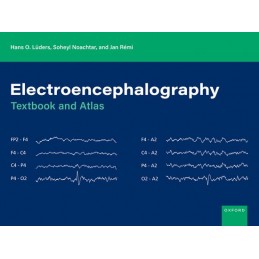Opis
Electroencephalography (EEG) is one of the oldest neurophysiological techniques used to evaluate brain activity and is a cornerstone of technical diagnostics in neurology. The technical advancement of electroencephalography in the last few decades, however, asks for a new approach to EEG reading. This textbook and atlas provides a systematic approach to normal and abnormal EEG patterns, serving as an instructional guide for the beginner in EEG and an essential reference for theexperienced EEG reader. Containing about 400 figures illustrating typical EEG patterns which are also available online in reformatted referential and bipolar montages, this book covers how electrical waves are generated into the brain, the equipment required to record electrical brain waves (includingthe set-up of EEG machines, electrodes, and procedures), biological and non-biological disturbances called artifacts in EEG recordings, and differentiation of normal and abnormal patterns in EEG. The reader will be introduced to a systematic analysis of EEG interpretation by defining the characteristics of the EEG patterns (polarity, localization, frequency, modulation etc.) and their clinical meaning, making this an essential text that should be on the bookshelf of every medical professionalusing EEG.
Szczegóły produktu
Indeks
102158
EAN13
9780197502334
ISBN
9780197502334
Opis
Rok wydania
2024
Numer wydania
1
Oprawa
twarda
Liczba stron
520
Waga (g)
2223
Section 1: Introduction; Section 2: Fundamentals of EEG; 2.1 Biological Basis of EEG; 2.1.1 Source of EEG signal; 2.1.1.1 Action Potentials; 2.1.1.2 Synaptic Potentials; 2.1.1.3 Spatial Arrangement of Electric Fields; 2.1.2 Fundamentals of Rhythmic EEG Activity; 2.2 Physical and Technical Fundaments of EEG; 2.2.1 Technical Structure; 2.2.1.1 Electrodes and Skin Contact; 2.2.1.3 Differential Amplifier; 2.2.1.4 Analog-to-Digital (AD) Conversion; 2.2.1.5 Video; 2.2.1.6 Electrical Safety; 2.2.2 Technical Characteristics of EEG Recording; 2.2.2.1 EEG Filters; 2.2.2.1.1 Electrotechnical Basis of Filters; 2.2.2.1.2 Phase Shift Due to Filters; 2.2.2.1.3 Recommended Filter Settings; 2.2.2.2 Editing the Digital EEG; 2.2.2.2.1 Reformatting; 2.2.2.2.2 Referential Montages; 2.2.2.2.3 Bipolar Montages; 2.2.2.2.4 Source Analysis and Mapping; 2.2.2.2.5 Automatic Spike Detection; 2.2.2.2.6 Automatic Seizure Detection; 2.2.2.2.7 Long term EEG monitoring; 2.2.3 Localization of EEG Potentials; 2.2.3.1 Polarity Convention; 2.2.3.2 Systematic Approach to Localization of EEG Potentials; 2.2.3.3 Advantages and Disadvantages of Bipolar and Referential Montages; 2.2.3.4 Localization of Asymmetries; 2.3 Artifacts ; 2.3.1 Non-biological Artifacts; 2.3.1.1 Electrode Artifacts; 2.3.1.2 Ballistic Artifacts; 2.3.1.3 Open Channel; 2.3.1.4 External Artifacts; 2.3.2 Biological Artifacts; 2.3.2.1 Bulb Movements; 2.3.2.2 Muscle Artifacts; 2.3.2.3 Glossokinetic Artifacts; 2.3.2.4 Eye Muscle Artifacts; 2.3.2.5 ECG Artifacts; 3 Clinical Electroencephalography ; 3.1 Recording of EEG ; 3.1.1 Default Settings for EEG Recording; 3.1.2 Recording of Newborn EEGs; 3.2 Activation Methods ; 3.2.1 Hyperventilation; 3.2.2 Photic Stimulation; 3.2.3 Sleep and Sleep Deprivation; 3.2.4 Eye Closure; 3.3 EEG Reading ; 3.3.1 Description of Abnormal EEG; 3.3.1.1 Frequency; 3.3.1.2 Amplitude; 3.3.1.3 Localization; 3.3.1.4 Shape and Temporal Behavior; 3.3.1.5 Responsiveness / Reactivity; 3.3.2 Reporting of EEG; 3.4 EEG Classification ; 3.4.1 Normal Patterns; 3.4.1.1 Physiological Wake EEG; 3.4.1.1.1 Posterior Alpha-Activity; 3.4.1.1.2 Central µ-Activity; 3.4.1.1.3 Frontal Beta Activity; 3.4.1.1.4 Temporal Theta Activity; 3.4.1.2 Physiological Sleep EEG; 3.4.2 Abnormal EEG; 3.4.2.1 Degree of EEG Abnormality; 3.4.2.2 State of Consciousness; 3.4.2.3 Slow and Suppression; 3.4.2.3.1 Background Slow (BS); 3.4.2.3.2 Intermittent Slow (IS); 3.4.2.3.2.1 Intermittent Rhythmic Slow (IRS); 3.4.2.3.2.2 Temporal Slow of the Elderly; 3.4.2.3.2.3 Hypnagogic/Hypnopompic Theta-Delta-Bursts; 3.4.2.3.2.4 Occipital Slow of Youth; 3.4.2.3.2.5 Eye Closure Activity; 3.4.2.3.2.6 Rhythmical Temporal Theta Bursts of Drowsiness; 3.4.2.3.2.7 Rhythmical Midline Theta; 3.4.2.3.3 Background Attenuation (BA); 3.4.2.3.4 Background Suppression (BSU); 3.4.2.3.5 Electrocerebral Silence (ECS); 3.4.2.4 Epileptiform Discharges (ED); 3.4.2.4.1 Spikes (SP); 3.4.2.4.2 Polyspikes (PSP) and Paroxysmal Fast (PF); 3.4.2.4.3 Benign Focal Epileptiform Discharges (BFED); 3.4.2.4.4 Spike-waves (SW); 3.4.2.4.5 Polyspike-Waves (PSW); 3.4.2.4.6 Three Hz Spike-Waves (3SW); 3.4.2.4.7 Slow-Spike-Waves (SSW); 3.4.2.4.8 Hypsarrhythmia (HYP); 3.4.2.4.9 Photoparoxysmal Response (PR); 3.4.2.4.10 Seizure Patterns (SEP); 3.4.2.4.10.1 Semiological Seizure Classification; 3.4.2.4.11 Status Patterns (STP); 3.4.2.4.12 Differential Diagnoses of Interictal Epileptiform Discharges; 3.4.2.4.12.1 Wicket Spikes; 3.4.2.4.12.2 Asymmetry, Increased Background; 3.4.2.4.12.3 Benign Epileptiform Transients of Sleep (BETS); 3.4.2.4.12.4 14 & 6 Hz Positive Spikes; 3.4.2.4.12.5 6 Hz Phantom Spike and Wave; 3.4.2.5 Periodic Patterns (PP); 3.4.2.5.1 Periodic Discharges; 3.4.2.5.2 Periodic Epileptiform Discharges (PED); 3.4.2.5.3 Triphasic Waves (TW); 3.4.2.5.4 Burst Suppression (BUS); 3.4.2.5.5 Burst Attenuation (BUA); 3.4.2.6 Differentiation of Non-Convulsive Status Epilepticus and Encephalopathies; 3.4.2.7 Special Patterns; 3.4.2.7.1 Excessive Beta (EB); 3.4.2.7.2 Asymmetry (ASY); 3.4.2.7.3 Sleep-Onset-REM (SOREM); 3.4.2.8 Special Patterns in Stupor and Coma; 3.4.2.8.1 Alpha-Coma (AK) and Alpha-Stupor (AS); 3.4.2.8.2 Spindle-Coma (SK) and Spindle-Stupor (SS); 3.4.2.8.3 Beta-Coma (BK) and Beta-Stupor (BS); 3.4.2.8.4 Theta-Coma (TK) and Theta-Stupor (TS); 3.4.2.8.5 Delta-Coma (DK) and Delta-Stupor (DS); Appendix 1: EEG Guidelines of the American Clinical Neurophysiological Society (ACNS); Appendix 2: Semiological Seizure Classification; References ;


 Dostawa
Dostawa
 Płatność
Płatność
 Zwroty
Zwroty
